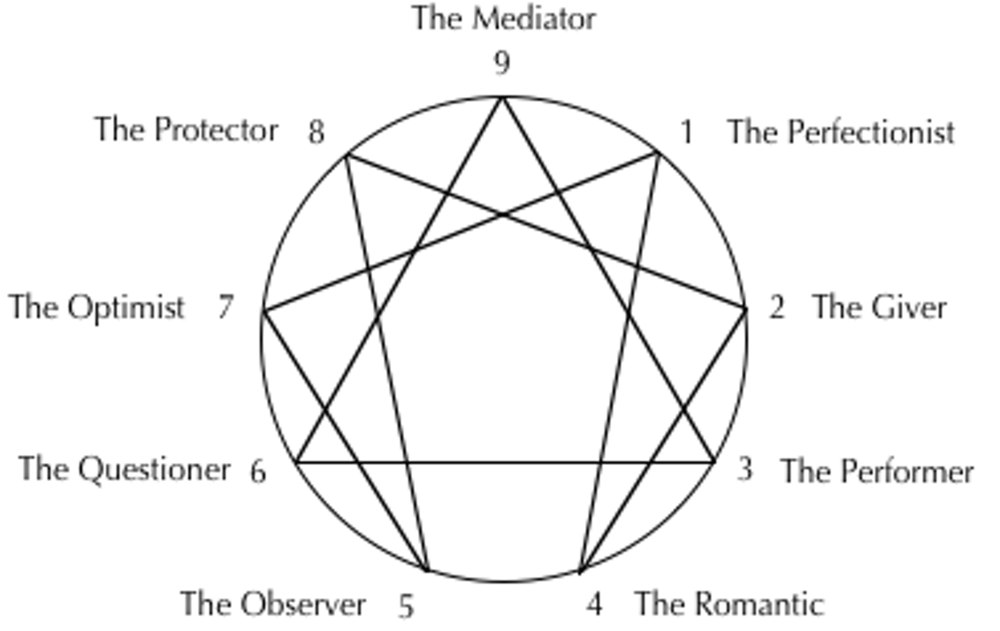The Enneagram of personality is an ancient, beautifully accurate, spiritual and psychological model of humanity. Describing nine personality types and their interactions, it enables us to look deeply into our own character, harmonise our daily lives and our relationships both personal and professional, and understand our personal path to growth.
 First described in the West by Gurdjieff, the Enneagram’s particular nine-pointed star is an ancient diagram, though no-one knows its origin. Not an arbitrary shape, it encapsulates the esoteric Laws of Three and Seven (octaves), is very like Pythagoras’ ninth seal symbolising humanity, and some researchers link ancient stone circles with the mathematics of the Enneagram.
First described in the West by Gurdjieff, the Enneagram’s particular nine-pointed star is an ancient diagram, though no-one knows its origin. Not an arbitrary shape, it encapsulates the esoteric Laws of Three and Seven (octaves), is very like Pythagoras’ ninth seal symbolising humanity, and some researchers link ancient stone circles with the mathematics of the Enneagram.
Sufis have called the Enneagram ‘a God-given tool for personal moral healing’. A conversion concept including the diagram and nine personality types has been part of Sufi ethical training for 1400 years. Christian mystics of the Desert Father tradition, in the third and fourth centuries, worked with the concept of converting vice to virtue, using the personality traits now named in the Enneagram. It seems to be a wisdom which surfaces when and where it is needed – and in surprising ways – as of course all spiritual truths do.
The Enneagram describes, amazingly accurately, nine distinct personality types, their variations, and the spiritual states of being with which they are linked. Furthermore, the flow of connecting lines shows the inter-relation between different aspects of each personality. At first it may be hard to identify our type: unlike other typologies, Enneagram type is defined not by behaviour but by something which is so fundamental to our personalities that we may not be aware of, or may actively deny, it.
The central premise is that each of us has one of the nine possible ‘chief features’, a focus of attention so deep it is usually hidden from our conscious awareness, which sets the tenor of our whole lives. Originally a way of coping with the outer world, by the time we are adult it is an automatic biased perspective (the ‘false self’). The key words are ‘passion’ – through which we focus on the world emotionally – and ‘fixation’ – our mental focus. In the grip of our passion/fixation, behaviour is automatic and often harmful to our true well-being, though it was originally developed as a protection.
The beautiful part is that this ‘false’ personality shows us our own spiritual path: not an enemy to be conquered, but our best friend, showing us what lessons we need to learn and how to learn them. The different passions and fixations developed to protect their ‘holy opposite’ (Holy Virtue and Holy Idea), which were ‘forgotten’ as ego developed, and to which we long to return. They are mimicked as well as masked by personality.
Linking personality type to spiritual potential in this way, the Enneagram makes it possible for the first time to bridge the gap between psychology (who we are not) and spirituality (who we truly are): a continuum of healing growth.
All mystic traditions recognise three ‘organs of perception’. When unconscious the head produces fear, the heart yearning, and the belly anger. The nine Enneagram types are variations on these three basic emotions: according to our type, one of these is the ruling ‘negative’ emotion, whether we are aware of it day-to-day or not.
The central triangle of the Enneagram shows the core personalities of each centre. It also represents the trinity of Hope (3), Faith (6), Love (9), and would teach us to open all three centres.
I am often asked: ‘When I know my type, what then?’. We start with the personality. According to the Enneagram the resentments, desires and fears that go to make it up are actually distorted expressions of the energy one works with to get to the higher states.
Working with the Enneagram, with myself and clients, I have found it more creative to recognise your passion, put your attention on it, learn to observe it and see what it teaches you about yourself. Part of this learning is in meditation, developing a strong inner witness (that part of ourselves which is not our personality), and part in simple day-to-day self-observation.
This process itself loosens the grip of the automatic response: it also gives insight into how to work with our issues. Different issues define each personality type, and the same strategy for emotional, psychological and spiritual growth doesn’t work with all types of people. So the first step for all types is to observe the underlying placements of attention that support repeating behaviours and emotions.
Finally, though we are all capable of feeling all human emotions, we actually experience life in radically different ways, and have vastly different responses to events, even to conversations. The Enneagram, like any personality typology, can be trivialised. Though this cannot be helped, I trust that its real meaning will survive through those who recognise its spiritual origin. Studying your own and others’ types fosters skilful living, personal growth, better relationships, a deeper understanding of all humanity, and ultimately, despite our different personality types, the experience that we all are one.
Karen A Webb has been teaching the Enneagram in the Narrative Tradition for over 20 years. She graduated from the Enneagram Professional Training Program in 1991 and now runs Enneagram Studies UK, providing open and tailored Enneagram workshops and consultations. Karen is a passionate, lifelong student of spirituality, comparative religion and psychology and lives in Malvern, UK.
© 2012 Singing Dragon blog. All Rights Reserved.
